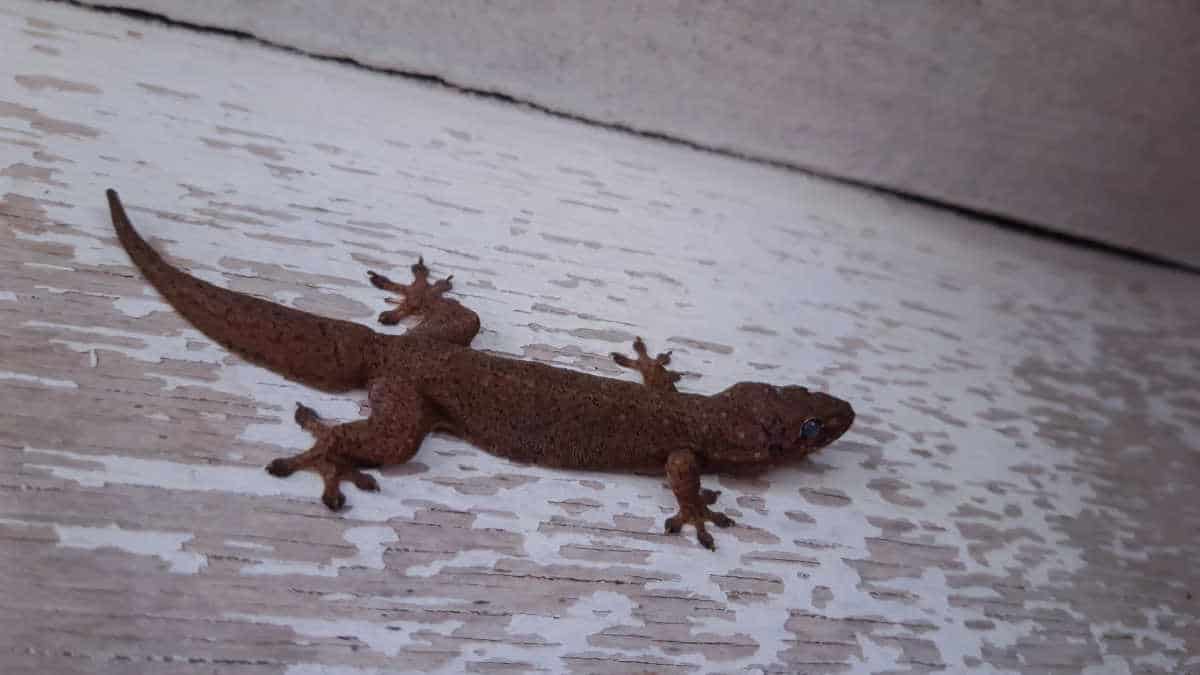Oklahoma, a diverse state with a wide range of habitats, is home to various species of lizards, including geckos. These fascinating creatures can be found in areas such as arid deserts, grasslands, and forests, displaying their unique behaviors and characteristics. Geckos, specifically the Mediterranean house gecko, are also known to be found in urban settings throughout Oklahoma, making them a familiar sight for many residents and reptile enthusiasts.
Among the gecko species commonly found in Oklahoma, the Mediterranean house gecko stands out due to its adaptability to different environments and its preference for urban areas. These geckos have a remarkable ability to climb, allowing them to find suitable habitats in residential areas, where they consume insects and spiders, providing natural pest control for homeowners.
Exploring the presence of geckos in Oklahoma not only offers valuable insights into the state’s rich biodiversity but also presents an opportunity to learn more about these remarkable reptiles. Understanding their habitat preferences, behavior, and ecological contributions will enhance our appreciation for these small yet fascinating creatures that thrive in the Sooner State.
Geckos in Oklahoma
Oklahoma hosts a diverse ecosystem, and among the fascinating creatures calling this state home are several species of geckos. These unique lizards can be found across various habitats within Oklahoma. Let’s explore some of the most common gecko species and their behaviors.
The Mediterranean house gecko is one of the most prevalent species of gecko in Oklahoma. As the name suggests, this gecko originated from the Mediterranean region and has become established in the state due to its adaptability. House geckos are nocturnal, mostly active during the night when they hunt for insects. Their skin color varies from brown to gray, allowing them to blend in with their surroundings. Mediterranean house geckos are often found near human dwellings, where they help control insect populations.
Another gecko species endemic to Oklahoma is the common spotted whiptail. This lizard is not a true gecko but rather belongs to the whiptail family. However, it shares some similarities with geckos, such as small body size and an affinity for basking in the sun. The common spotted whiptail features a pattern of light and dark spots along its body, which helps it stay camouflaged among foliage.
In addition to geckos, Oklahoma is home to a variety of other lizard species. The prairie lizard is one such example, found across almost every terrestrial habitat within the state. Active during March through October, these lizards are known for their agility and speed. Similar to geckos, they play a significant role in controlling insect populations.
Although Oklahoma has a limited number of gecko species, they still hold an essential place within the state’s ecosystem and contribute to maintaining a healthy balance in the environment. While most geckos and lizards in Oklahoma are harmless or even beneficial to humans, it is crucial always to approach wildlife with respect and observe from a safe distance.
Physical Description and Behavior
Coloration and Pattern
Geckos in Oklahoma are known for their diverse coloration and patterns. The Mediterranean house gecko, one of the common species in the region, can be found in various shades of light colors, such as white, pink, light brown, or sandy yellow. These vibrant colors enable them to camouflage and blend in with their natural surroundings, giving them an advantage when it comes to escaping predators or hunting prey.
Territorial and Active
Geckos in Oklahoma generally exhibit territorial behavior and are quite active in their natural habitats. They are known to show warning behavior when sensing potential threats. Prairie lizards, another lizard species found in Oklahoma, have highly keeled, pointed, and overlapping scales that play a key role in their agility and speed, aiding the lizards in establishing and maintaining their territories while keeping potential rivals at bay.
Tail Adaptation for Escape
Geckos possess a unique adaptation in their tails that serve as an invaluable tool in escaping predators. Their tails can be longer than their bodies, which not only helps in balance but also acts as a distraction for predators. In case of an attack, a gecko can release its tail to escape while the predator is distracted by the detached tail. The gecko then regenerates a new tail over time, ensuring its continued survival.
Arboreal and Nocturnal
Oklahoma geckos are mostly arboreal, meaning that they prefer to live in trees and other elevated areas. The Prairie Lizards, for example, are known for spending most of their time off the ground, perching in trees, on fences, and even on sunflowers to avoid predators and find suitable prey. Geckos’ nocturnal lifestyle enables them to be active during the cooler nights, which is advantageous in the warm climate of Oklahoma. As nighttime hunters, their keen eyesight and agile movement help them successfully forage for food while avoiding predators.
Popular Species of Geckos and Lizards Found in Oklahoma
Oklahoma has a diverse range of reptiles, including various species of geckos and lizards. In this section, we will discuss some of the popular species found in the state.
Mediterranean House Gecko
The Mediterranean House Gecko is a common nocturnal reptile found in Oklahoma. These small geckos can often be seen around homes and buildings, where they feed on insects and spiders. They are characterized by their pinkish-gray color and distinctive transparent scales.
Eastern Collared Lizard
The Eastern Collared Lizard, also known as the Mountain Boomer, is an agile and visually striking reptile found in Oklahoma. They can often be seen in rocky habitats and have a distinctive feature: a collar-like pattern around their neck. These lizards are known for their bright colors and ability to run on two legs.
Little Brown Skink
The Little Brown Skink is a small, elusive lizard that can be found in Oklahoma’s wooded areas and leaf litter. They have a brownish color with a broad, dark stripe running down each side of their body. As insectivores, they feed mainly on small insects and spiders in the wild.
Coal Skink
Coal Skinks are medium-sized lizards with a unique appearance, including dark stripes on their bodies and bright blue tails in juveniles. They prefer moist environments such as forests near streams or creeks. In Oklahoma, Coal Skinks can be found hiding under rocks or logs, and their main diet consists of insects and other small invertebrates.
Common Spotted Whiptail
The Common Spotted Whiptail is a species of spiny-tailed lizard known for their long, slender body and distinctively striped pattern. They are primarily found in open, sandy habitats in Oklahoma and are active during the day. As carnivores, their diet mainly consists of insects, spiders, and small invertebrates.
Green Anole
Green Anoles are small to medium-sized lizards with slender bodies and bright green coloration. They are found in Oklahoma, often in trees or bushes, where they are active during the day and feed on insects. One of their unique characteristics is their ability to change color from green to brown based on their surroundings or emotions.
Habitat and Distribution
Oklahoma is home to a variety of gecko species that can be found in diverse habitats, ranging from arid deserts to lush grasslands and forests. These geckos exhibit unique habitat preferences, making each species adapted to thrive in different environments.
The banded gecko is often found in rocky outcroppings and cliffs, benefiting from the shelter and camouflage provided by these natural features. These habitat preferences extend across North America, where the banded gecko can be found in other regions with similar conditions.
In urban areas, the Mediterranean gecko has become a common sight. This nonnative species has successfully established itself across Oklahoma and has been well-documented in cities throughout the state. The Mediterranean gecko is known for its adaptability to human environments, often residing on the walls of buildings and other structures.
The prairie lizard is a widespread species that occurs throughout Oklahoma and its distribution extends from western Nevada to New York, and from southern South Dakota to Mexico. With a broad range that covers both urban and rural areas, the prairie lizard is capable of being active during any month of the year in Oklahoma, provided temperatures remain high enough.
Additionally, the eastern collared lizard, also known as the mountain boomer, is the Oklahoma state lizard. This species is characterized by its distinct black collar on the neck and can be found in various habitats throughout the state.
In conclusion, Oklahoma’s geckos showcase a diverse set of habitat preferences, ranging from rocky landscapes to urban environments. With their adaptability and resourcefulness, these species continue to thrive in both natural and human-made habitats across the state.
Diet and Feeding Habits
Geckos found in Oklahoma have a diverse diet that consists mainly of small invertebrates, including insects and spiders. Being nocturnal animals, they actively hunt for food at night and take shelter during the day. They play a crucial role in controlling insect populations, as they have a strong appetite for these small creatures.
One of the primary food sources for geckos in Oklahoma is crickets. These insects are widely available and provide geckos with essential nutrients. Crickets are an ideal food choice because they are full of protein and relatively easy for geckos to catch and consume.
In addition to crickets, geckos are known to eat various other insects and invertebrates, such as:
- Moths: Geckos are attracted to these flying insects, which are also rich in nutrients.
- Flies: These common insects provide a quick and easy meal for geckos and are often found in their diet.
- Spiders: Although not insects, spiders are also consumed by geckos, adding diversity to their diet.
It is essential to note that the specific food sources consumed by geckos may vary depending on the particular species of gecko and their habitat. Providing a proper diet for these reptiles is important for maintaining their health and overall well-being. Ensuring they have access to a variety of prey items can support their growth and development.
Feeding habits for geckos can vary based on the individual and their environmental conditions. Generally, geckos will consume several insects or other invertebrates each night during their active hunting periods. The frequency and size of their meals can depend on factors like age, size, and reproductive status.
In conclusion, the diet and feeding habits of Oklahoma geckos revolve primarily around consuming insects, spiders, and other small invertebrates. A diverse diet consisting of different prey items contributes to their overall health, making them essential members of their ecosystem by helping to control insect populations.
Reproduction and Life Cycle
Geckos in Oklahoma have fascinating reproductive habits and life cycles. These reptiles typically lay eggs, with some species laying a few clutches each year, depending on environmental factors and the availability of food. The breeding season typically starts in spring and continues until late summer or early fall.
Geckos typically lay their eggs in hidden spaces, such as crevices, tree hollows, or even within human-made structures. The female geckos are responsible for laying the eggs, often choosing well-protected locations to ensure the safety of their offspring. Each clutch contains one to two eggs, depending on the species. The incubation period for the eggs usually lasts around one to three months, with variations among different species.
As the eggs hatch, the young geckos, known as hatchlings, emerge from their shells. These hatchlings are fully independent and capable of fending for themselves from the moment they are born. Although they are smaller than adults, their appearance and coloration are quite similar, allowing them to blend into their environment effectively.
The life cycle of geckos is a fascinating process, showcasing the resilience and adaptability of these small reptiles. As hatchlings grow into adulthood, they have to navigate their natural habitat, avoiding predators and searching for food sources. Adult geckos have a relatively long lifespan, with some species living up to 5 years or more in the wild.
The natural history and reproductive strategies of Oklahoma’s geckos serve as a testament to their adaptability and perseverance in a constantly changing environment. By understanding their reproduction and life cycle, we can appreciate the intricate balance of nature and the vital role these small creatures play in maintaining the ecosystems in which they reside.
Conservation and Regulations
Oklahoma is home to a variety of gecko species, whose populations are affected by several factors, primarily habitat loss. As one of the most diverse ecosystems in the United States, Oklahoma has drawn increasing attention from scientists and nature enthusiasts alike due to its unique and fascinating creatures.
Habitat loss poses a significant threat to the survival of geckos and other reptiles in the state. As urbanization, agriculture, and industrialization expand, their natural environments are disrupted, leading to fragmentation and destruction. Consequently, it is crucial to prioritize and implement conservation measures to maintain and restore their habitats.
The Oklahoma Conservation Commission collaborates with various organizations to conserve, protect, and restore the state’s natural resources. This is done to ensure that the native species, including geckos and other amphibians, have a chance to thrive and survive for future generations.
As for regulations, the state of Oklahoma has set specific rules that protect reptiles and amphibians from illegal trade and overexploitation. It is unlawful to engage in any commercial activities involving the collection of reptiles and amphibians from the wild that are indigenous to or have their range extending into Oklahoma. There are, however, provisions for certain species, such as rattlesnakes, water turtles, and aquatic salamanders.
In conclusion, habitat loss is a major concern for the conservation of geckos and other reptiles in Oklahoma. The state addresses this issue through a combination of conservation efforts and regulations aimed at protecting native wildlife. By maintaining a balance between human development and nature, the state ensures a sustainable environment for its unique ecosystem and the fascinating creatures that reside within it.
Geckos as Pets
Geckos are fascinating reptiles that can make great pets for those interested in keeping an exotic and low-maintenance animal. They come in a variety of sizes and colors, and with over 1,600 different species of geckos, there are plenty of options to choose from.
Capturing a wild gecko in Oklahoma is not recommended, as they may carry diseases or ailments that could spread to other animals or humans. Instead, it’s best to acquire a captive-bred gecko from a reputable breeder. This ensures the health and safety of both the gecko and its new owner.
In terms of care, geckos are relatively low-maintenance compared to other pets. They require a proper habitat with temperature control and ample hiding spots. Geckos are ectothermic, which means they rely on external heat sources to regulate their body temperature. This is why it is essential to provide a gradient of temperatures in their enclosure so they can self-regulate.
As for diet, geckos are insectivores, meaning they consume insects such as crickets, mealworms, and roaches. It’s vital to provide a varied diet and supplement their food with essential vitamins and minerals to ensure optimal health.
Some popular gecko species kept as pets include:
- Leopard geckos: Known for their hardy nature, leopard geckos are nocturnal and possess fascinating patterns. They typically reach a length of 8-10 inches and can live up to 20 years with proper care.
- Crested geckos: Native to New Caledonia, these geckos are arboreal (tree-dwelling) and require a vertically oriented enclosure. They are relatively easy to care for and can be social when handled consistently.
In summary, geckos make fantastic pets for those who appreciate their unique qualities and can provide a proper environment tailored to their specific needs. Considering communication, habitat, and dietary requirements will significantly improve the chances of successfully keeping a gecko as a pet.
Resources and Field Guides
Oklahoma is home to diverse wildlife, including several species of geckos. If you’re interested in learning more about these fascinating creatures, there are several resources available, including field guides and wildlife departments.
One of the best resources for information about geckos and other reptiles in Oklahoma is the Oklahoma Department of Wildlife Conservation. They provide detailed information on various species and subspecies of reptiles and amphibians that are native to the state.
If you would like a comprehensive book on this topic, consider purchasing A Field Guide to Oklahoma’s Amphibians and Reptiles by Greg and Lynnette Sievert. This guide is available from the Oklahoma Department of Wildlife Conservation and provides in-depth information on Oklahoma’s diverse amphibians and reptiles.
When embarking on outdoor adventures in search of Oklahoma’s geckos, it’s helpful to have field equipment and guides at hand. The Outdoor Store offers a variety of tools and materials to ensure you’re well-prepared for your reptile-seeking endeavors.
Funding for the study, conservation, and management of Oklahoma’s reptiles, amphibians, and other wildlife is supported by the Wildlife Diversity Fund. This fund helps protect these fascinating creatures and their habitats, ensuring they continue to thrive in Oklahoma for future generations to enjoy.
In conclusion, if you are interested in geckos and the varied reptile species in Oklahoma, there are numerous resources available. From field guides to conservation efforts, you can be confident in your knowledge of the state’s wildlife and contribute to their preservation.







